BUICK PARK AVENUE 1994 Owners Manual
Manufacturer: BUICK, Model Year: 1994, Model line: PARK AVENUE, Model: BUICK PARK AVENUE 1994Pages: 324, PDF Size: 17.01 MB
Page 291 of 324
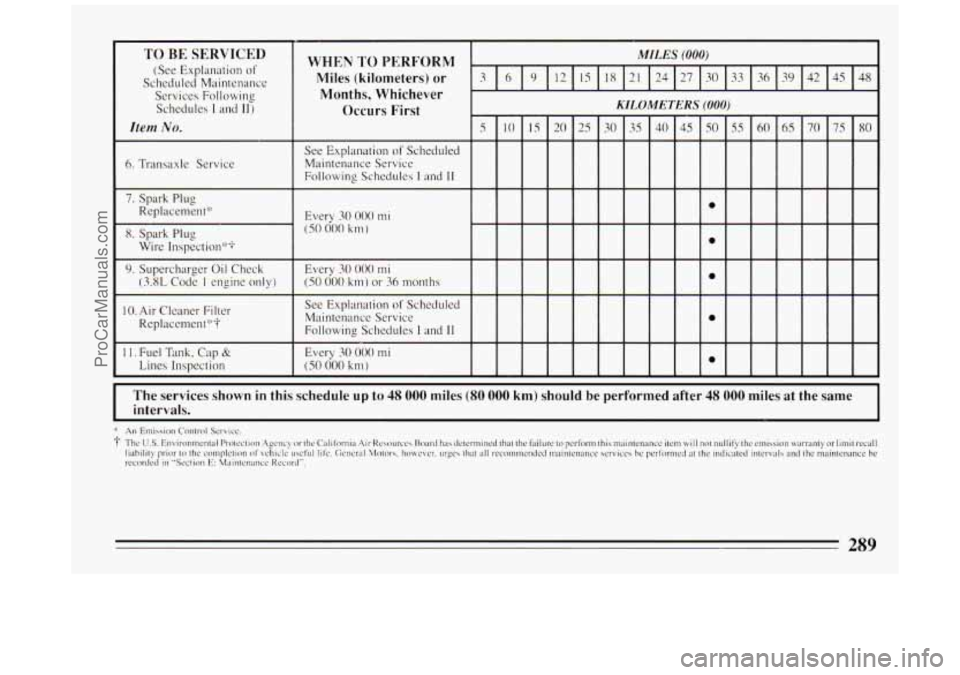
TO BE SERVICED
(See Explanation of
Scheduled Maintenance
Services Following
Schedules
I and 11)
Item No. ~~ ~
~ __
6. Transaxle Service
7. Spark Plug
Replacement”
X. Spark Plug
Wire Inspection*+
9. Supercharger Oil Check
(3.8L Code 1 engine only)
10. Air Cleaner Filter
Replacement*’t
11. Fuel Tank, Cap &
Lines Inspection
WHEN TO PERFORM
Miles (kilometers) or
IS 18 21 24 27 30 33 36 39 42 45 48
Months, Whichever
MILES (000)
Occurs First
See Explanation of Scheduled
Maintenance Service
Following Schedules
I and 11
Every 30 000 mi
(SO 000 km)
tttt
See Explanation of Schedulcd
Maintenance Scrvice
Following Schedules
1 and I1
Every 30 000 mi
(SO 000 km) IIII
KILOMETERS (000) I
The services shown in this schedule up to 48 000 miles (80 000 km) should be performed after 48 000 miles at the same
I
289
ProCarManuals.com
Page 292 of 324
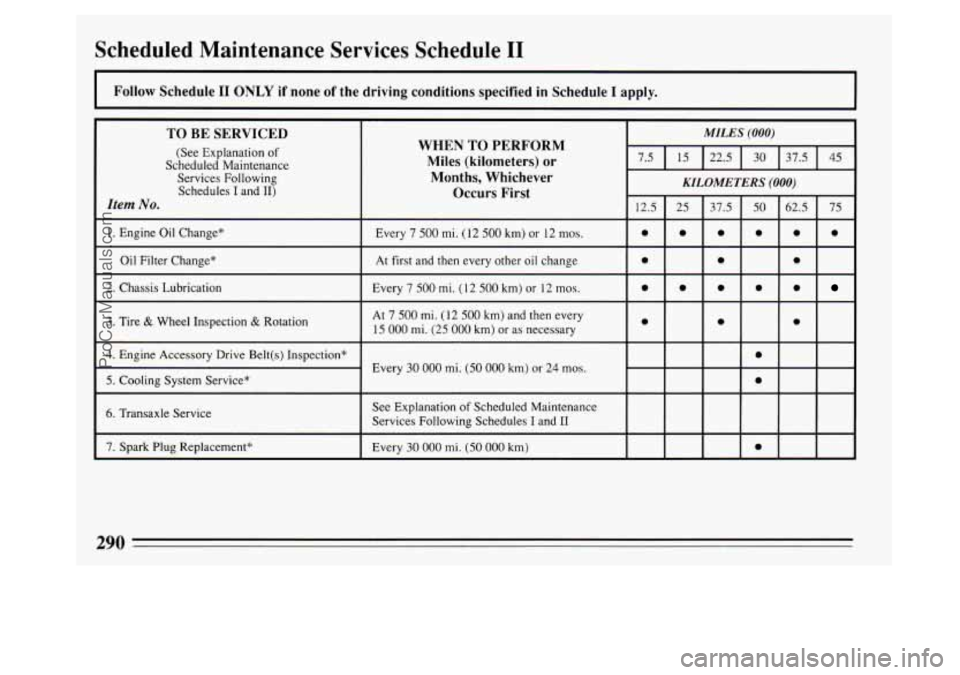
Scheduled Maintenance Services Schedule I1
I Follow Schedule I1 ONLY if none of the driving conditions specified in Schedule I apply.
TO BE SERVICED
(See Explanation of
Scheduled Maintenance
Services Following
Schedules I and 11)
Item No.
1. Engine Oil Change*
Oil Filter Change*
2. Chassis Lubrication
3. Tire
& Wheel Inspection & Rotation
4. Engine Accessory Drive Belt(s) Inspection*
5. Cooling System Service*
6. Transaxle Service
7. Spark Plug Replacement*
WHEN TO PERFORM
Miles (kilometers) or
Months, Whichever
Occurs First
MILES (000)
KILOMETERS (000)
I I 12.5 I 25
Every
7 500 mi. (12 500 km) or 12 mos. PIo
At first and then every other oil change
Every
7 500 mi. ( 12 500 km) or 12 mos.
At 7 500 mi. ( 12 500 km) and then every
15 000 mi. (25 000 km) or as necessary
Every
30 000 mi. (50 000 km) or 24 mos.
See Explanation of Scheduled Maintenance
Services Following Schedules I and I1
Every
30 000 mi. (50 000 km) 37.5
50 62.5
0 0 0
0 0
0 0 0
0 0
0
0
0
290
ProCarManuals.com
Page 293 of 324
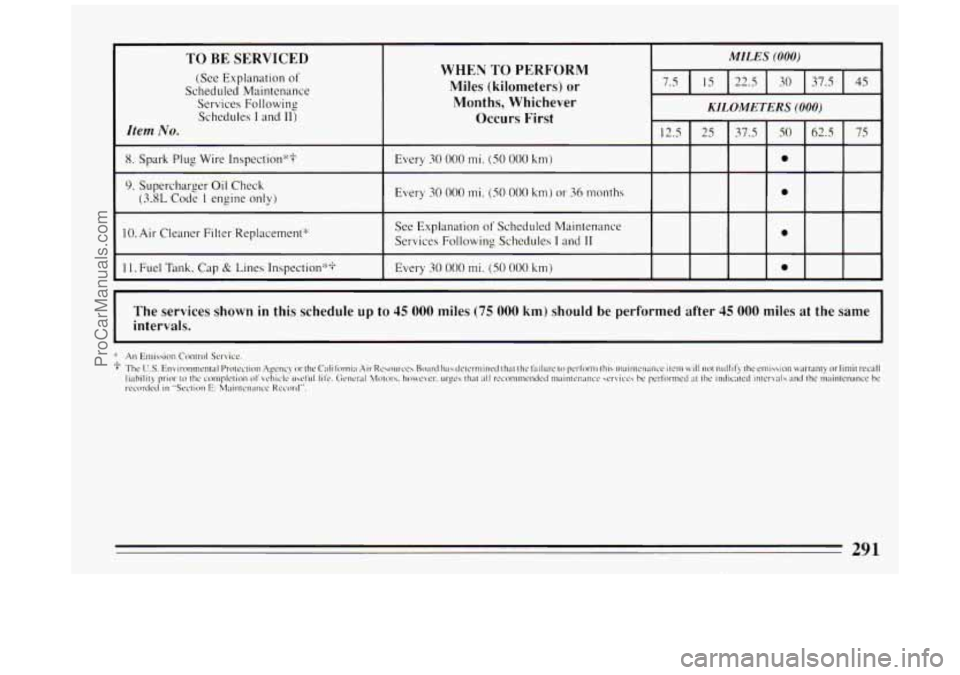
TO BE SERVICED
(See Explanation of
Scheduled Maintenance
Services Following
Schedules
I and 11)
Item No.
8. Spark Plug Wire Inspection*?
9. Supercharger Oil Check
(3.8L Code I engine only)
10. Air Cleaner Filter Replacement"
1 I. Fuel Tank. Cap & Lines Inspection**
WHEN TO PERFORM
Miles (kilometers) or
Months, Whichever
Occurs First
I MILES (000)
22.5 45 37.5 30
KILOMETERS (000)
12.5 I 25 I 37.5 I SO I 62.5 I 75 ~~
Every 30 000 mi. (SO 000 km) e
Every 30 000 mi. (50 000 km) or 36 months I
See Explanation of Scheduled Maintenance
Services Following Schedules
I and I1
Every 30 000 mi. (SO 000 km) e
0
I
The services shown in this schedule up to 45 000 miles (75 000 km) should be performed after 45 000 miles at the same
intervals.
I
291
ProCarManuals.com
Page 294 of 324
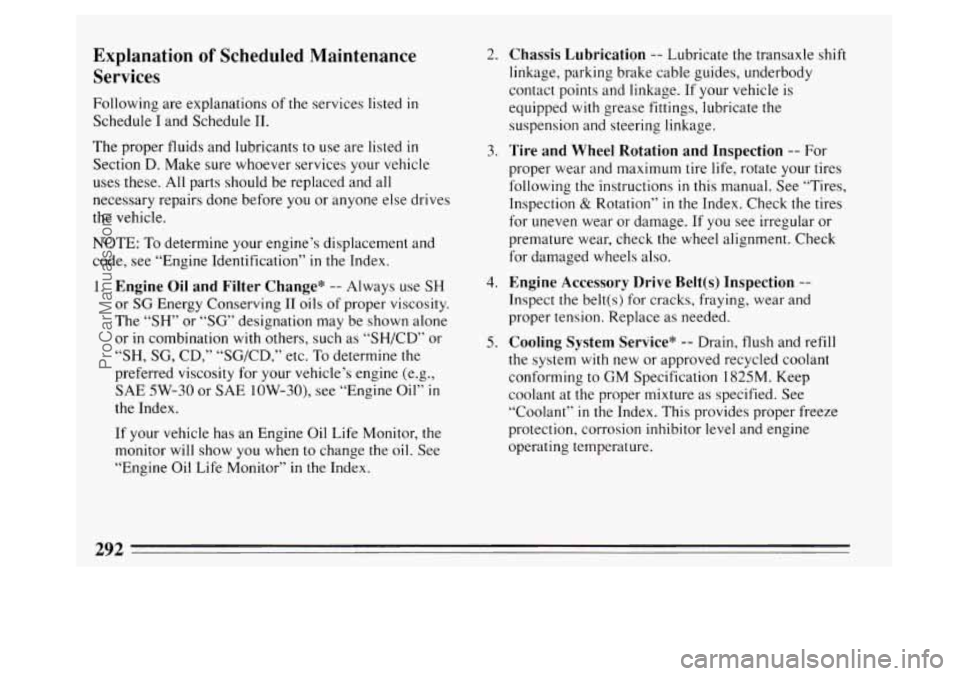
Explanation of Scheduled Maintenance
Services
Following are explanations of the services listed in
Schedule I and Schedule 11.
The proper fluids and lubricants to use are listed
in
Section D. Make sure whoever services your vehicle
uses these. All parts should be replaced and all
necessary repairs done before you or anyone else drives
the vehicle.
NOTE: To determine your engine’s displacement and
code, see “Engine Identification”
in the Index.
1. Engine Oil and Filter Change* -- Always use SH
or SG Energy Conserving I1 oils of proper viscosity.
The
“SH” or “SG” designation may be shown alone
or
in combination with others, such as “SH/CD” or
“SH,
SG, CD,” “SG/CD,” etc. To determine the
preferred viscosity for your vehicle’s engine (e.g., SAE
5W-30 or SAE low-30), see “Engine Oil” in
the Index.
If your vehicle has an Engine Oil Life Monitor, the
monitor will show you when to change the oil. See
“Engine Oil Life Monitor”
in the Index. 2.
Chassis Lubrication -- Lubricate
the transaxle shift
linkage, parking brake cable guides, underbody
contact points and linkage. If your vehicle is
equipped
with grease fittings, lubricate the
suspension and steering linkage.
3. Tire and Wheel Rotation and Inspection -- For
proper wear and maximum tire life, rotate your tires
following the instructions
in this manual. See “Tires,
Inspection
& Rotation” in the Index. Check the tires
for uneven wear or damage. If you see irregular or
premature wear, check the wheel alignment. Check
for damaged wheels also.
4. Engine Accessory Drive Belt(s) Inspection --
Inspect the belt(s) for cracks, fraying, wear and
proper tension. Replace as needed.
5. Cooling System Service* -- Drain, flush and refill
the system
with new or approved recycled coolant
conforming to GM Specification 1825M. Keep
coolant at the proper mixture as specified. See
“Coolant”
in the Index. This provides proper freeze
protection, corrosion inhibitor level and engine
operating temperature.
292
ProCarManuals.com
Page 295 of 324
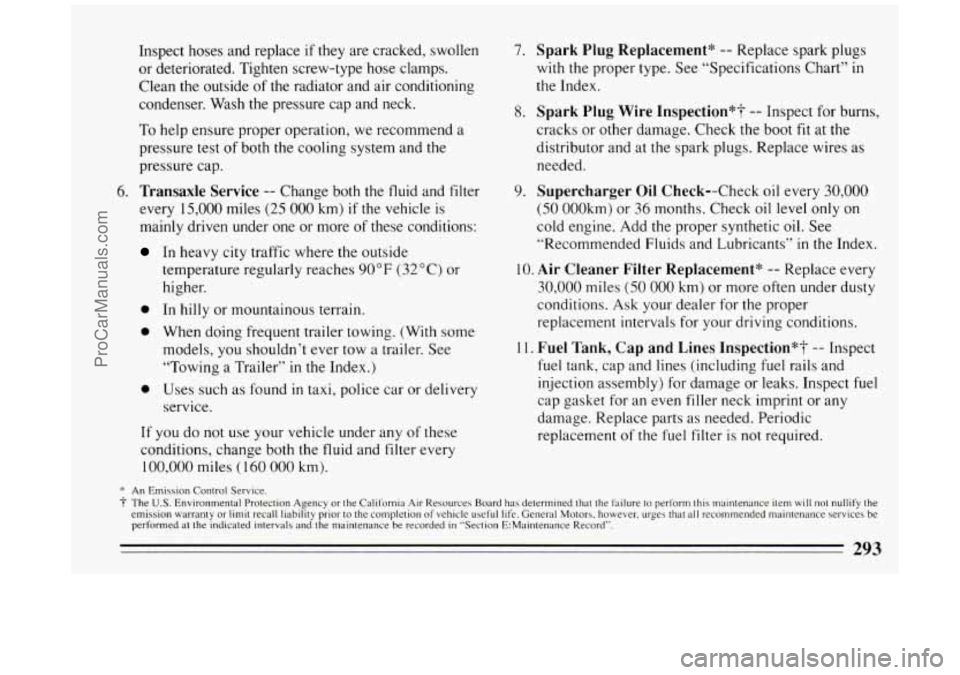
Inspect hoses and replace if they are cracked, swollen
or deteriorated. Tighten screw-type hose clamps.
Clean the outside of the radiator and air conditioning
condenser. Wash the pressure cap and neck.
To help ensure proper operation, we recommend a
pressure test of both the cooling system and the
pressure cap.
6.
Transaxle Service -- Change both the fluid and filter
every
15,000 miles (25 000 km) if the vehicle is
mainly driven under one or more
of these conditions:
In heavy city traffic where the outside
temperature regularly reaches
90°F (32°C) or
higher.
0 In hilly or mountainous terrain.
0 When doing frequent trailer towing. (With some
models, you shouldn’t ever tow a trailer. See
“Towing a Trailer”
in the Index.)
0 Uses such as found in taxi, police car or delivery
service.
If you do not use your vehicle under any of these
conditions, change both the fluid and filter every
100,000 miles ( 160 000 km).
7. Spark Plug Replacement* -- Replace spark plugs
with the proper type. See “Specifications Chart”
in
the Index.
8. Spark Plug Wire Inspection*-f -- Inspect for burns,
cracks or other damage. Check the boot
fit at the
distributor and at the spark plugs. Replace wires as
needed.
9. Supercharger Oil Check--Check oil every 30,000
(50 000km) or 36 months. Check oil level only on
cold engine. Add the proper synthetic oil. See
“Recommended Fluids and Lubricants” in the Index.
10. Air Cleaner Filter Replacement* -- Replace every
30,000 miles (50 000 km) or more often under dusty
conditions. Ask your dealer for the proper
replacement intervals for your driving conditions.
1 1. Fuel Tank, Cap and Lines Inspection*? -- Inspect
fuel tank, cap and lines (including fuel rails and
injection assembly) for damage or leaks. Inspect fuel
cap gasket for an even filler neck imprint or any
damage. Replace parts as needed. Periodic
replacement
of the fuel filter is not required.
* An Emission Control Service.
-f The US. Environmental Protection Agency or the California Air Resources Board has determined that the failure to perform this maintenance item will not nullify the
emission warranty or limit recall liability prior to the completion of vehicle useful life. General Motors. however. urges that all recommended maintenance services be
performed at the indicated intervals and the maintenance be recorded in “Section E:Maintenance Record”.
293
ProCarManuals.com
Page 296 of 324
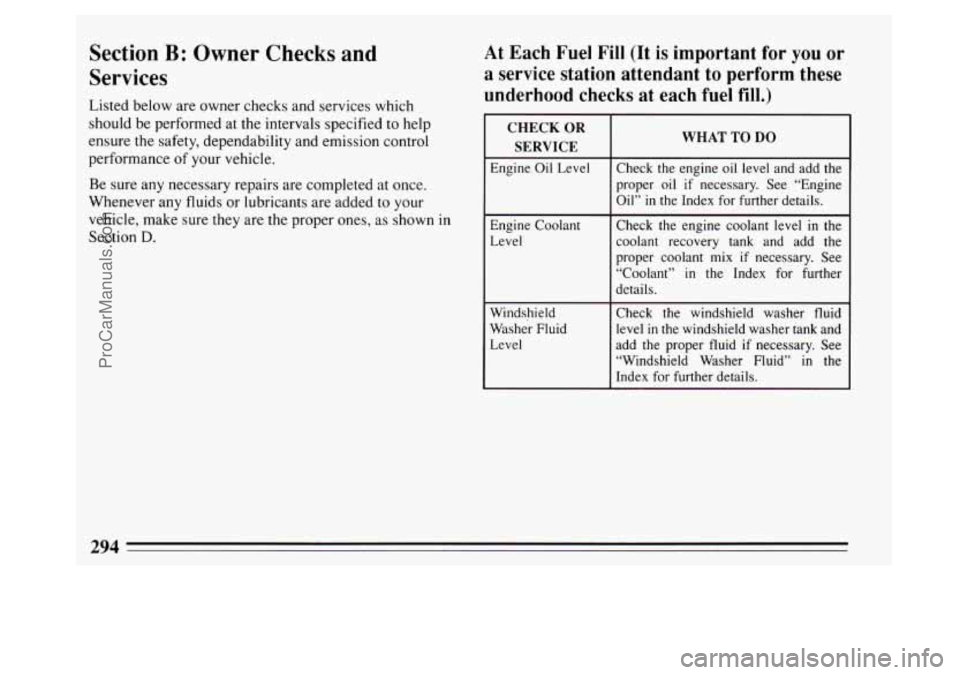
Section B: Owner Checks and
Services
Listed below are owner checks and services which
should be performed at the intervals specified to help
ensure
the safety, dependability and emission control
performance of your vehicle.
Be sure any necessary repairs are completed at once.
Whenever any fluids or lubricants are added to your
vehicle, make sure they are the proper ones, as shown in
Section
D.
At Each Fuel Fill (It is important for you or
a service station attendant to perform these
underhood checks at each fuel
fill.)
Engine Oil Level
Engine Coolant
Level
Washer Fluid
Level
WHAT TO DO
Check the engine oil level and add the
proper oil
if necessary. See “Engine
Oil” in the Index for further details.
Check the engine coolant level
in the
coolant recovery tank and add the
proper coolant mix
if necessary. See
“Coolant”
in the Index for further
details.
Check the windshield washer fluid
level
in the windshield washer tank and
add the proper fluid
if necessary. See
“Windshield Washer Fluid”
in the
Index for further details.
294
ProCarManuals.com
Page 297 of 324
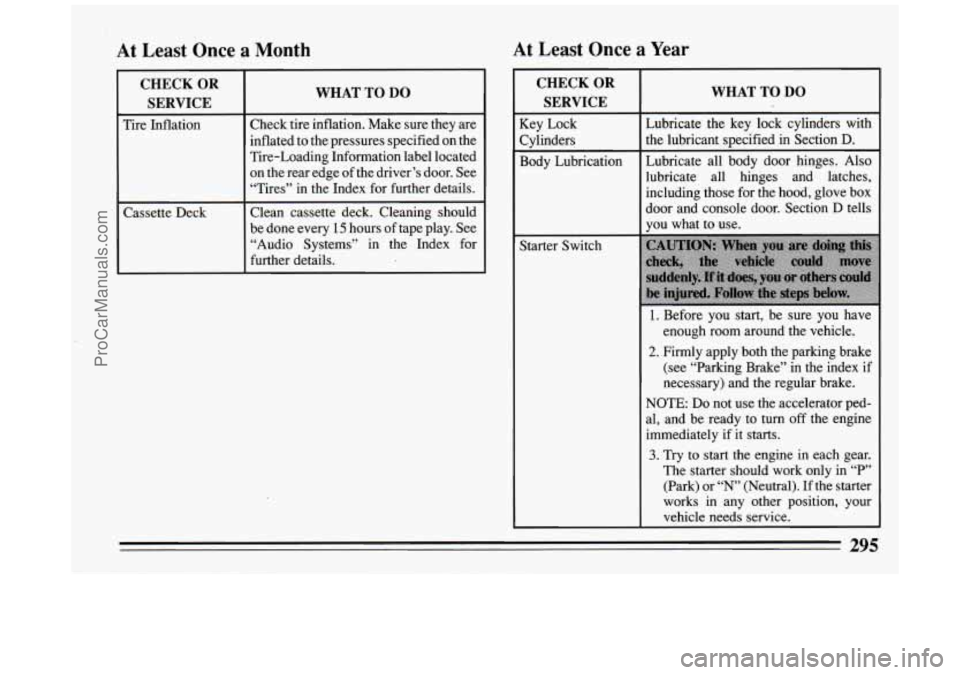
At Least Once a Month At Least Once a Year
CHECKOR SERVICE I
WHAT TO DO
Tire Inflation
Tire-Loading Information label located
inflated to the pressures specified on the Check
tire inflation. Make sure they are
on the rear edge of the driver’s door. See
“Tires” in the Index for further details.
Cassette Deck Clean cassette deck. Cleaning should
be done every
15 hours of tape play. See
“Audio Systems”
in the Index for
further details.
CHECK OR
SERVICE
Key Lock
Cylinders
Body Lubrication
Starter Switch
WHAT TO DO
Lubricate the key lock cylinders with
the lubricant specified in Section
D.
Lubricate all body door hinges. Also
lubricate all hinges and latches,
including those for the hood, glove box
joor and console door. Section
D tells
you what to use.
1. Before you start, be sure you have
enough room around
the vehicle.
2. Firmly apply both the parking brake
(see “Parking Brake” in the index
if
necessary) and the regular brake.
NOTE:
Do not use the accelerator ped-
al, and
be ready to turn off the engine
immediately if it starts.
3. Try to start the engine in each gear.
The starter should work only in
“P’
(Park) or “N’ (Neutral). If the starter
works in any other position, your
vehicle needs service.
295
ProCarManuals.com
Page 298 of 324
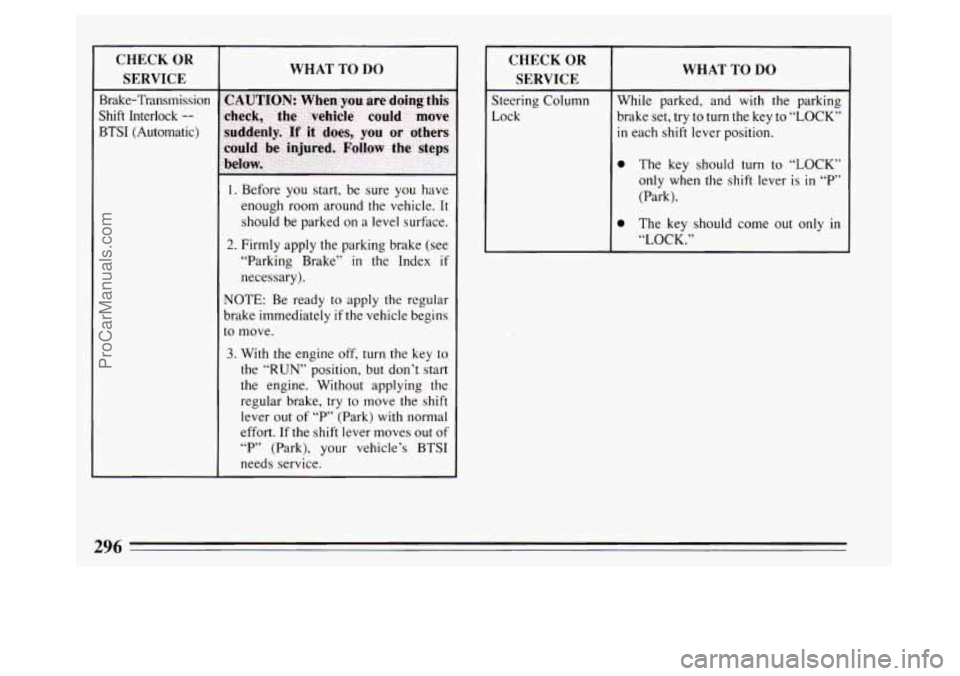
CHECK OR
SERVICE
Brake-Transmission
Shift Interlock
--
BTSI (Automatic)
WHAT TO DO
I. Before you start, be sure you have
enough room around the vehicle.
It
should be parked on a level surface.
2. Firmly apply the parking brake (see
“Parking Brake”
in the Index if
necessary).
NOTE: Be ready to apply the regular
brake immediately
if the vehicle begins
to move.
3. With the engine off, turn the key to
the
“RUN’ position, but don’t start
the engine. Without applying the
regular brake, try to move the shift lever out of “P” (Park) with normal
effort. If the shift lever moves out of
“P” (Park), your vehicle’s BTSI
needs service.
WHAT TO DO
Steering Column
brake set, try to turn the key to
“LOCK” Lock
While parked, and with the parking
in each shift lever position.
0 The key should turn to “LOCK”
only when the shift lever is
in “P’
0 The key should come out only in
1 “LOCK.”
296
ProCarManuals.com
Page 299 of 324
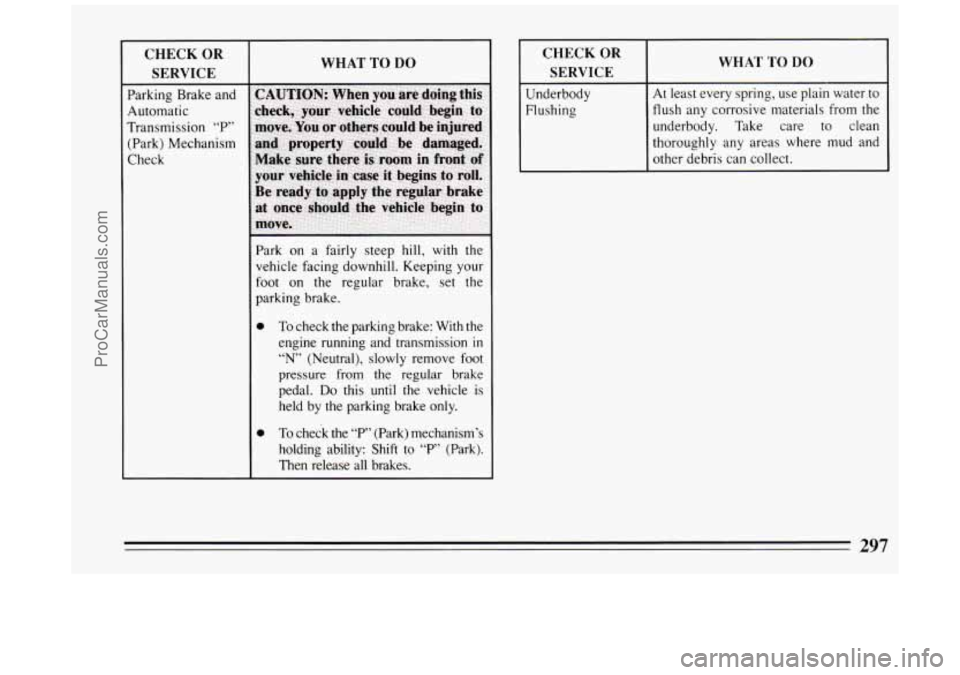
CHECK OR
SERVICE
Parking Brake and
Automatic
Transmission
“P”
(Park) Mechanism
Check
WHAT TO DO
0 To check the parking brake: With the
engine running and transmission
in
“N” (Neutral), slowly remove foot
pressure
from the regular brake
pedal.
Do this until the vehicle is
held by the parking brake only.
0 To chedk the “P” (Park) mechanism’s
holding ability: Shift
to “P’ (Park).
Then release all brakes.
CHECKOR SERVICE I
WHAT TO DO
Underbody
Flushing At least every spring, use plain water to
flush any corrosive materials from the
underbody. Take care
to clean
thoroughiy any areas where mud and
other debris can collect.
297
ProCarManuals.com
Page 300 of 324
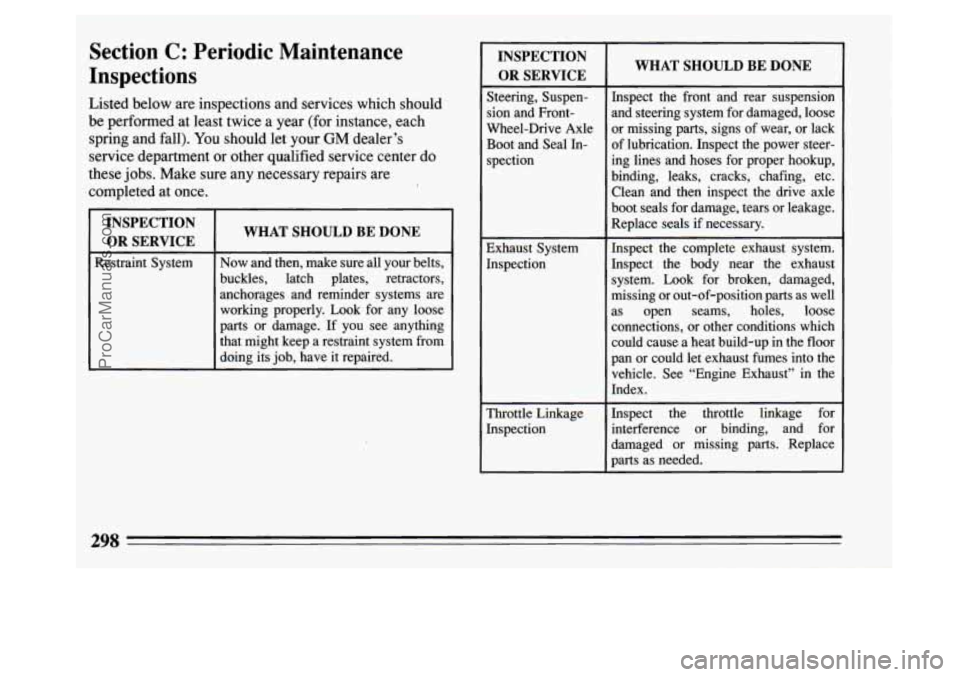
Section C: Periodic Maintenance
Inspections
Listed below are inspections and services which should
be performed at least twice a year (for instance, each
spring and fall). You should let your GM dealer’s
service department or other qualified service center
do
these jobs. Make sure any necessary repairs are
completed at once.
INSPECTION
OR SERVICE
Restraint System
WHAT SHOULD BE DONE
Now and then, make sure all your belts,
buckles, latch plates, retractors,
anchorages and reminder systems are
working properly. Look for any loose
parts or damage. If you see anything
that might keep a restraint system from
doing its job, have it repaired.
I
INSPECTION
OR SERVICE I WHAT SHOULD BE DONE I
Steering, Suspen-
sion and Front-
Wheel-Drive Axle Boot and Seal In-
spection Inspect the
front and rear suspension
and steering system for damaged, loose
or missing parts, signs of wear, or lack
of lubrication. Inspect the power steer-
ing lines and hoses for proper hookup,
binding, leaks, cracks, chafing, etc.
Clean and then inspect the drive axle
boot seals
for damage, tears or leakage.
Replace seals if necessary.
Exhaust System
Inspection Inspect
the complete exhaust system.
Inspect the body near the exhaust
system. Look for broken, damaged,
missing or out-of-position parts as
well
as open seams, holes, loose
connections, or other conditions which
could cause a heat build-up in the floor
pan or could let exhaust fumes into the
vehicle. See “Engine Exhaust” in the
Index.
Throttle Linkage Inspect the throttle linkage for
Inspection interference or binding, and for
damaged or missing parts. Replace
parts as needed.
298 ~
ProCarManuals.com